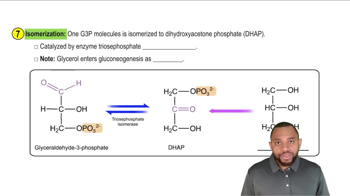Here are the essential concepts you must grasp in order to answer the question correctly.
Chirality
Chirality refers to the geometric property of a molecule that makes it non-superimposable on its mirror image. Molecules with chirality typically have one or more chiral centers, usually carbon atoms bonded to four different substituents. This property is crucial in biochemistry, as chiral molecules can have different biological activities depending on their orientation.
Recommended video:
Chiral Centers
A chiral center, often a carbon atom, is a point in a molecule where the arrangement of atoms leads to chirality. For a carbon to be considered a chiral center, it must be bonded to four distinct groups. Identifying chiral centers is essential for understanding the stereochemistry of molecules, which can influence their reactivity and interaction with biological systems.
Recommended video:
Dihydroxyacetone Phosphate (DHAP)
Dihydroxyacetone phosphate (DHAP) is a three-carbon sugar phosphate that plays a significant role in carbohydrate metabolism, particularly in glycolysis and gluconeogenesis. It is an important intermediate that can be converted into glyceraldehyde-3-phosphate, another key metabolite. Understanding DHAP's structure and function is vital for studying metabolic pathways and energy production in cells.
Recommended video:
Gluconeogenesis Concept 8

 Verified step by step guidance
Verified step by step guidance Verified video answer for a similar problem:
Verified video answer for a similar problem:

